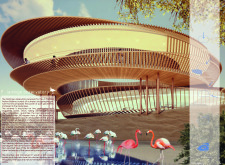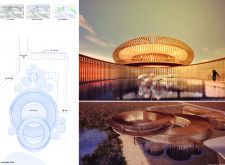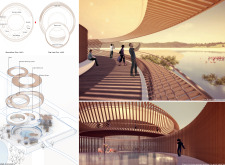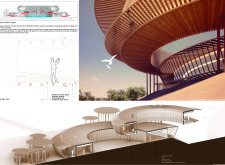5 key facts about this project
The Flamingo Observatory proposal for the Al Wathba Nature Reserve presents a thoughtful design that complements the natural landscape. Located in an area rich in biodiversity, the observatory serves as a space for visitors to engage with and appreciate the unique surroundings. The design features two overlapping circular volumes that create functional areas while ensuring expansive views of the reserve.
Site Integration
The project responds to the landscape's contours and features, using its geometry to enhance the experience of people visiting the site. Public areas are organized on the ground level to encourage interaction with nature. A café takes advantage of its location, providing a comfortable spot for guests to gather while enjoying the scenic vistas. This design prioritizes protection from the sun while allowing visitors to remain connected to their surroundings.
Environmental Considerations
An internal courtyard is an important aspect of the design, incorporating a large body of water that serves multiple purposes. It adds beauty to the space and helps cool the air, promoting a pleasant environment through natural ventilation. A disabled-accessible ramp connects visitors from the ground floor to the first level, allowing everyone to reach the panoramic platform and display area. This thoughtful feature ensures that all visitors can enjoy the natural beauty of the reserve.
Material Use
The structure predominantly uses wood, which offers a warm and inviting feel while maintaining a lightweight profile. The building skin consists of a rain screen made from slats, adding to the visual interest of the design. This façade provides shade throughout the year and allows for natural airflow, contributing to a comfortable atmosphere both inside and out.
Overall, the design prioritizes sustainability and views the surrounding environment as an integral part of the experience. The layout encourages visitors to connect with the wildlife and landscape, reflecting a commitment to preserving and appreciating the ecological value of the Al Wathba Nature Reserve. The interplay of spaces and materials ultimately creates a place where nature and built form coexist harmoniously.






















































